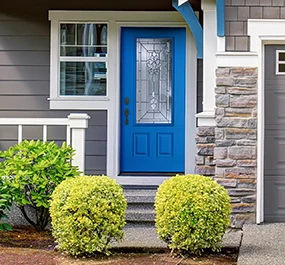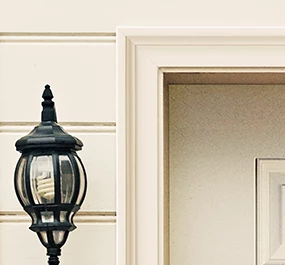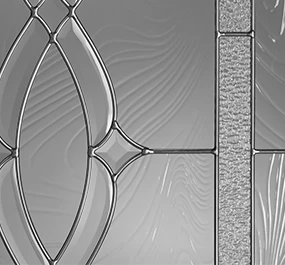When it comes time to getting a new door, there’s a lot to take into consideration. Factors like door material and door style will be high priorities, but one key choice to make is whether to go with a pre-hung or slab door.
Learning the difference between these different types of doors is important for making the best choice. Keep reading for a comparison of pre-hung vs. slab doors and when to choose one over the other.
What is a Pre-hung Door?
A pre-hung door is a door slab that is already hung in the door frame by the hinges. This creates a nearly complete package—though some features like the doorknob and strike plate need to be added. Pre-hung doors will typically need to be painted or stained as well.
Pros of a Pre-hung Door
Convenience
Pre-hung doors can make the door installation process much quicker. Because the door frame is included with the door, there is no need to build the frame or hang the door, cutting the overall time the project will take.
Door Seal
Because pre-hung doors are a nearly complete door unit, the door is already fitted to be weather-tight. This removes the need to ensure the door is sealed during installation—another reason why pre-hung doors generally require less time to install.
Cons of a Pre-hung Door
Difficult to manage
While pre-hung doors are typically easier to install, they are more difficult to handle being that they are much heavier than just the door slab itself. This is especially true of pre-hung exterior doors which generally have high density door cores.
Pre-hung door units can weigh upwards of 100 pounds, so they will require at least two people to move. They also need to be transported and handled carefully as they are fairly fragile before they are installed.
Cost
Though a pre-hung door is a convenient option, there is additional cost associated with the additional convenience and materials provided. The overall difference in price will also depend on specific elements like door material, door design, or door glass.
What is a Slab Door?
A slab door is a door without the frame or hinges. Door slabs can be purchased with a pre-cut hole for the doorknob, but the hardware—including doorknob, hinges, and strike plate—need to be purchased separately.
Pros of a Slab Door
Design Options
Opting to go with a slab door can provide more design flexibility than pre-hung units. While many traditional door styles may be available in either type, more personalized door options may only be available as slab doors. Additionally, antique doors or other repurposed options typically only come as slab doors as well.
Easier to handle
Because a slab door is just the door itself, it’s much easier to transport and manage than a pre-hung door unit.
Cons of a Slab Door
Can be difficult to install
While neither a pre-hung door nor a slab door are easy to install, a slab door can make for a more difficult installation—especially when the entire frame is new or needs to be replaced. Not only will it take more time to build the frame and hang the door, but it also requires skill and patience to ensure the door is hung and sealed properly.
In either case, professional installation is recommended, but those who opt for a DIY approach may have a more difficult time with a slab door depending on their experience level.
May require modification
Unlike a pre-hung door that is built ready to use, door slabs may require additional modifications to ensure they fit properly. Depending on the condition of the door, a slab door may need to be planed, sanded, or straightened. This is especially true of vintage or antique doors that may have warped or become damaged over time.
Pre-hung vs. Slab Door: Which is the Right Choice?
There’s no definitive answer on whether pre-hung or slab doors are best—the choice will be situational depending on a variety of factors. Let’s take a look at a few of the most important considerations that can influence the choice.
Type of project
One of the most important factors in choosing between pre-hung vs. slab doors is what type of project is being completed.
For situations where there is an existing frame in place, a slab door is often a great choice being that the door can simply be hung in the existing frame.
Conversely, if it’s new construction or the existing frame is damaged or needs to be replaced, a pre-hung door is a good choice being that the new frame is included with the door.
Budget
A slab door is often the budget-friendly choice because there is less included—especially in situations where the frame does not need to be replaced. Additionally, reusing hardware like hinges from an existing door can also help create additional savings.
For situations where the frame needs to be replaced, be sure to include the total cost of materials for the frame and the door hardware when comparing prices to similar pre-hung doors.
Interior vs. exterior doors
In general, pre-hung doors are best for exterior projects. This is due to the fact that the doors come weather-tight off the shelf, meaning improved energy efficiency and performance against the elements.
Either pre-hung or slab doors are a good fit for interior doors. However, because door seals aren't as important for interior doors, opting to save on a door slab may be a good option.
Door design and customization
For those looking to create a unique or highly customized entryway, a slab door may be the best option given the broader range of design options. Slab doors are also best if you’re interested in using a recycled or repurposed door.
Get Started on Your Next Project with Plastpro
Whether you opt for a pre-hung or slab door, Plastpro has resources available to help with door installation. Check out our guides on installing pre-hung and slab doors to assist with your next project.
Additionally, Plastpro’s selection of exterior fiberglass doors are available in either pre-hung or door slab varieties to suit your needs. Featuring enhanced durability, energy efficiency, and door security, Plastpro’s fiberglass doors are built to keep your home safe and comfortable for a lifetime.
Visit our Where to Buy page to find a Plastpro dealer near you, or use our Doorability tool to see a Plastpro door on your home today.



